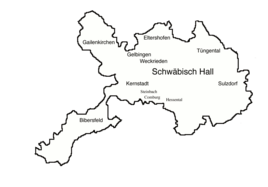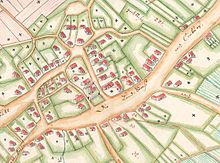Hessental
|
Hessental
City of Schwäbisch Hall
Coordinates: 49 ° 6 ′ 24 ″ N , 9 ° 46 ′ 27 ″ E
|
|
|---|---|
| Residents : | 7195 (Dec. 31, 2017) |
| Incorporation : | July 1, 1936 |
| Postal code : | 74523 |
| Area code : | 0791 |
|
Location of Hessental in Schwäbisch Hall
|
|
Hessental is the largest district of the county town of Schwaebisch Hall of Baden-Württemberg district Schwäbisch Hall .
geography
Hessental is located in the south-east of Schwäbisch Hall on the edge of the Haller Plain and the Swabian-Franconian Forest and is traversed by the Waschbach and tributaries from this.
history
From the 11th to the 13th century, Hessental - formerly written in Hessen th al - was home to an aristocratic family that had the rump of a unicorn in its coat of arms. It should have been ministerials from the Counts of Comburg-Rothenburg. Your castle probably stood on a "free-standing hill dominating the village". The first documentary mention was around 1100 . Until the Reformation , the place was a subsidiary of Steinbach ; The chapel of St. Matthew from 1365 was used as a church.
In the 16th century, the imperial city of Hall brought the high authorities to itself and thus took over the manorial rights over the place. As a result, a large part of the community became part of the Haller Land Territory and was subordinate to the Halle Office (In der) Schlicht .
The Reformation was implemented by Hall, whereas the Counter-Reformation , which came from the Comburg Monastery , kept the Comburgers Catholic. Therefore a Catholic and a Protestant school each came into being; this separation lasted until 1839, after which there was a joint school for Catholics and Protestants.
After the dissolution of the imperial city and the takeover of the Haller land areas in 1802, the place became part of the Duchy of Württemberg , which was elevated to an electorate in 1803 and a kingdom in 1806 . Hessental was subordinated to the new Oberamt Hall .
In 1867, Hessental received a train station and was thus connected to the rail network of the Württemberg State Railways . In 1936 it was incorporated into Schwäbisch Hall. In 1939 the independent Protestant parish of St. Matthew was established .
In military history Hessental, played a role because since 1936 a military airfield of the Air Force was established there. Bombers, night fighters and the Me 262 were stationed in Hessental and were finally assembled in the Hasenbühl forest between Hessental and Sulzdorf . Until 1993, the former air base under the name Dolan Barracks served the US Army as a location.
On September 13, 1944, the Protestant church, 14 residential and 25 agricultural buildings were severely damaged in an air raid, which was probably aimed at the air base; one resident was killed.
The Hessental concentration camp was a subcamp of the Natzweiler-Struthof concentration camp in Alsace that existed from summer 1944 to April 1945 . In the summer of 1944 it was set up in a former barrack camp of the Reich Labor Service at the Hessental train station. The first occupation with 600 prisoners took place on October 14, 1944.
traffic
The former "Flugplatz Hessental" was expanded into a civilian airfield after military use in the mid-1990s ( Flugplatz Schwäbisch Hall-Hessental ). In the station Schwäbisch Hall Hessental the railway lines meet Crailsheim-Heilbronn and Waiblingen-Schwäbisch Hall Hessental each other. In addition, the two country roads L 1060 and L 1056 meet in the village .
economy
The "Breitloh / Karl-Kurz-Areal industrial area" is located in the immediate vicinity of the train station on the site of the former Kurz barrel factory. Until the bankruptcy in 1998, the company was one of the largest companies in the city of Schwäbisch Hall. Another industrial area ("Gewerbegebiet Solpark") is located south of the airfield.
Buildings
Churches
- A previous building of the Protestant Church of St. Matthew is first documented in 1365 and was probably built from the remains of an abandoned castle. In 1731 the nave was renewed and the tower rebuilt. The church was largely destroyed in the air raid in 1944 and rebuilt on an enlarged scale between 1948 and 1950.
- In 1964 the Catholic Church of St. Mary, Queen of Peace was established.
Hotel "Die Krone"
In 1907 the Gasthaus zur Krone was described by Eugen Gradmann as a "simple rococo building with a dwarf and French roof". Gradmann mentioned a ceiling painting in a room on the first floor depicting Abraham's hospitality . Stucco medallions in the same room showed the four seasons, and the client's coat of arms was visible in a stucco oven niche. Today's Ringhotel Krone was once the Limpurgic or, from 1541, Halle Schenkstatt Hessental. It went through many hands. In 1754 a new inn was built on the old square; The client was Johann Michael Winkler. In the 19th century the property was sold to the dialect poet and member of the state parliament, Johannes Nefflen , at a price of 36,000 guilders . The Johann Nefflen room in the hotel reminds of him today. In 1873 the inn became the property of the Dürr family. The traditional inn and hotel has been operated by Teresa Senioren-Wohnen Servicegesellschaft mbH since 2018. In the new building of the house, advita Pflegedienst GmbH has also been operating an "advita house" since 2018, in which various forms of living, care and support are offered for senior citizens.
See also
- Schwäbisch Hall-Hessental airfield
- Hessental concentration camp
- Hessental death march
- Einkorn , mountain spur above the village, with the ruins of the pilgrimage church to the 14 helpers in need
Web links
- Hessental on the website of the city of Schwäbisch Hall
- from Hessental to: State Institute for the Environment Baden-Württemberg (LUBW) ( information )
Individual evidence
- ↑ Population figures in the suburbs. In: schwaebischhall.de, accessed on November 8, 2018 (as of December 31, 2017).
- ↑ Day care facilities for children in Hessental. In: schwaebischhall.de, accessed on November 7, 2018.
- ↑ Hessenthal municipality. In: Rudolph Friedrich von Moser: Description of the Oberamt Hall. Cotta, Stuttgart 1847, pp. 218–221, here: p. 220 ( preview in Google book search).
- ↑ http://www.schwaebischhall.de/buergerstadt/geschichte/hessental.html
- ↑ a b c Eugen Gradmann : Hessenthal . In: The art and antiquity monuments of the city and the Oberamt Schwäbisch-Hall . Paul Neff Verlag, Esslingen a. N. 1907, OCLC 31518382 , pp. 100-101 ( archive.org ).
- ↑ The history of Hessental on www.schwaebischhall.de
- ^ Hessental Castle - Evangelical Matthew Church ( Memento from January 3, 2014 in the Internet Archive ). In: matthaeusgemeinde.de, accessed on November 7, 2018.
- ^ Daniel Stihler: Haller barrels on the roof of the world: The barrel factory Karl Kurz KG in Hessental sponsored expeditions 50 years ago. In: Haller Tagblatt . June 6, 2013, accessed November 7, 2018.
- ↑ Johannes Nefflen's biography ( memento from January 3, 2014 in the Internet Archive ). In: hotel-diekrone.de, accessed on November 7, 2018.
- ↑ Hotel & Gasthof "Die Krone" - Guest House, Celebrations & Events. Retrieved on August 4, 2020 (German).
- ↑ advita Haus Hessental | Assisted living & day care. Retrieved August 4, 2020 .



